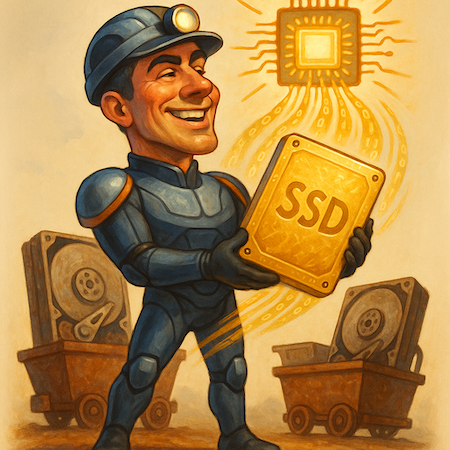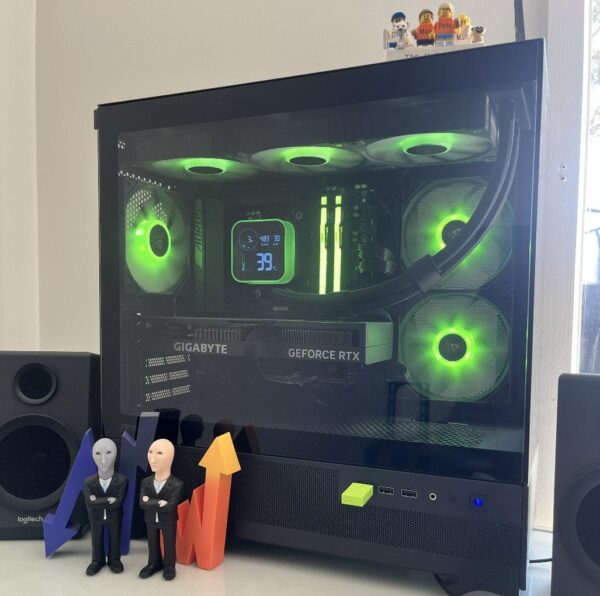 When people talk about the “arms race” in AI, they usually mean GPUs, the “AI superchips” powering the revolution.
When people talk about the “arms race” in AI, they usually mean GPUs, the “AI superchips” powering the revolution.
And here at Investor’s Daily over the years I’ve also written to you about the importance of compute memory.
But something else I’ve not touched on as much, still mentioned, but not at great length is the other critical piece of the puzzle that will usher in our mind-bending AI future.
I’ve known of its importance like any other AI-critical technology, but what I didn’t realise was the massive scale of the opportunity in play.
Arguably, it’s bigger than GPUs or “superchips”, bigger than memory, bigger than AI power that’s getting a massive run right now (i.e. nuclear stocks again).
Because without this game changing tech, AI simply… forgets.
20th century tech won’t cut it
When I built my own little AI factory (see in the image below) for home earlier this year there were numerous components that I needed for the thing to function.
The motherboard, the power unit, the CPU chip, the GPU “chip” (the GPU is really a big hunk of a thing), the memory, the cooling array and… the storage.

Admittedly, you might think that the storage side of things isn’t as important maybe as it once was thanks to “the cloud”.
But let’s not forget “the cloud” is just a massive storage array somewhere that’s not next to me at my desk.
I do have a hefty SSD (solid state drive) in my PC (you can’t see it; it’s tucked away behind the hulking Nvidia GeForce RTX GPU). But I also heavily use Dropbox as my primary cloud provider.
What I didn’t realise is just how much Dropbox (and other cloud providers) rely on HDDs (hard disk drives) for storage.
In fact, Dropbox explains they have as much as 90% of their fleet is advanced HDDs.
But it was an announcement from Western Digital recently that shocked me.
Buried in the announcement was a statistic I couldn’t quite believe…
Nearly 80% of the world’s cloud data still lives on HDDs.
Yes, actual disk drives.
The 3.5-inch CD looking things inside those clunky drives. Like the ones you’d hear whirring inside your old desktop tower. The ones that always failed in my laptops well before the laptop was truly ready to pop its clogs.
HDDs (hard disk drives) are mechanical stalwarts. They rely on spinning magnetic platters (like a CD) and tiny arms that swing back and forth to read and write data.
It’s elegant 20th-century engineering… but for 21st-century AI, it may cause a bit of a problem the faster and more advanced AI models get.
Every millisecond the drive takes to spin up, a GPU somewhere sits idle, burning thousands of dollars in wasted electricity.
Worse still, HDDs eat up space and power… the two things data centres can least afford.
What HDDs do very well is they’ve traditionally been able to contain more storage. In excess of 100TB (terabytes) which had put SSDs to shame.
Western Digital proudly called HDDs the “backbone of the AI data economy.”
Which is kind of like saying the horse-and-cart is the backbone of Amazon Prime.
Admittedly, they’re not wrong (for now at least).
And from the research I’ve been undertaking, it’s clear there’s a lot of massive advancements in HDD technology that is still in play.
But it also shows that for all the upscaling of existing infrastructure, at some point, it will have to change.
When it does, as it does, that’s going to present a huge opportunity to the companies that can reshape the storage solutions for AI factories.
And it’s why the mega-hyperscalers like Microsoft, Amazon and Google are scrambling to migrate to flash-based SSDs. These drives have no moving parts, store data in non-volatile memory, and deliver near-instant access.
They cost more, again, for now. But the improvement in latency kills HDD. And in AI, latency means everything.
Western Digital’s press release only said one thing to me… we’re on the brink of an all-out melt-up for those companies producing the AI-friendly cutting-edge SSDs for AI factories.
Here’s a perfect example of what that looks like.
Solidigm (the storage arm of SK Hynix) just launched its monster D5-P5336 drive.
Each one packs up to 122.88TB, draws only 25 watts, and can reduce rack space nine-fold while slashing energy use by 90%.
That completely rewrites the economics of HDD vs SSD for AI factories.
Then there’s Pure Storage, the all-flash darling of Silicon Valley. Its flagship FlashBlade//EXA system hits 10 terabytes per second of throughput and claims to cut data-centre energy and space use by 85%.
When you’re feeding GPU clusters that cost hundreds of thousands of dollars a pop, those savings all of a sudden reshape the general thinking about costs and capital expenditure on AI compute, when your storage slashes your operating costs and ratchets up your efficiency.
The AI arms race isn’t just about who has the most compute anymore. It’s also about who can feed that compute the fastest, cheapest, and most efficiently.
So, who are the major players in storage that you need to be looking at here?
Here are five to get you started…
The Top 5 Storage Titans of our AI future
- Solidigm / SK Hynix (000660.KS)
The new SSD superpower. Its 122TB QLC drives enable 9:1 rack reduction and 90% lower power use. A direct bridge between storage and compute efficiency.
- Micron (MU)
Yes, they dominate memory, but their recent restructure also has them clearly focused on storage now too. Its 6600 ION SSD delivers 67% higher density than comparable HDDs and with an eye on the future, its next-gen DRAM (HBM3E) links directly to GPU memory.
- Pure Storage (PSTG)
The flash disruptor. It’s redefining data-centre architecture for the AI era, exabyte-scale flash systems, NVIDIA-validated performance, and wildly fast throughput at insane scale.
- Western Digital (WDC)
Still the backbone of storage with 80% market share in HDDs. But its push into heat-assisted magnetic recording (HAMR) aims to keep HDDs relevant for cold storage for some time still.
- Seagate (STX)
Like WDC, you still can’t ignore Seagate. Their last major HDD rival, betting on new multi-actuator and NVMe-connected drives to speed up mechanical storage for AI archives.
Western Digital’s “80% HDD for cloud” figure really did catch me off guard. But in that I see enormous opportunity.
Let me put it to you this way…
My expectation is that within ten years 100% of AI factories run advanced SSD technology. No HDDs, all SSD.
To switch out HDDs for SSDs at that scale equates to billions… trillions in capital expenditure, that flows through primarily to five big players.
The world’s current AI infrastructure still runs on mechanical disks designed decades ago. And that’s simply unsustainable.
As models like GPT-6 and xAI’s Grok-3 devour trillions of data points, the ability to retrieve, index and re-feed that data is pure competitive advantage.
Flash storage is faster, denser, and more energy efficient. It’s also the gateway to the next frontier, memory-class storage, where the line between RAM and SSD blurs entirely.
Micron’s HBM3E and Samsung’s Z-NAND technologies hint at that future. Data won’t just be stored but it will be alive and ready to move and compute in the same cycle. The stuff of science fiction.
AI “brains” might all be related to computing power, but its entire circulatory system is pumping with data.
How that data is stored, and how fast it can move, will define the winners of the next decade.
Chips may get the glory (and headlines), but the real fortunes will be made in storage.
Until next time,

Sam Volkering
Contributing Editor, Investor’s Daily
P.S. The AI boom isn’t slowing but the real money won’t come from where everyone’s looking. As I showed you today, chips may get the glory, but the real fortunes will be made in the infrastructure quietly powering them. James Altucher calls this kind of moment a “Wealth Window” — a short period when trillions shift from old tech to new, creating once-in-a-decade opportunities for investors who act early. He’s found one opening right now tied to the same technological transition reshaping AI. You can see the full details right here.



